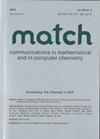Bifurcation Dynamics and Control Mechanism of a Fractional-Order Delayed Brusselator Chemical Reaction Model
IF 2.4
2区 化学
Q2 CHEMISTRY, MULTIDISCIPLINARY
Match-Communications in Mathematical and in Computer Chemistry
Pub Date : 2022-08-01
DOI:10.46793/match.89-1.073x
引用次数: 26
Abstract
Building differential dynamical systems to describe the changing relationship among chemical components is a vital aspect in chemistry. In this present manuscript, we put forward a new fractional-order delayed Brusselator chemical reaction model. By virtue of contraction mapping principle, we investigate the existence and uniqueness of the solution of fractional-order delayed Brusselator chemical reaction model. With the aid of mathematical analysis technique, we consider the non-negativeness of the solution of the fractional-order delayed Brusselator chemical reaction model. Making use of the theory of fractional-order dynamical system, we explore the stability and Hopf bifurcation issue of the fractional-order delayed Brusselator chemical reaction model. By designing a reasonable controller, we have availably controlled the time of emergence of Hopf bifurcation of the fractional-order delayed Brusselator chemical reaction model. A sufficient criterion guaranteeing the stability and the onset of Hopf bifurcation of the fractional-order controlled delayed Brusselator chemical reaction model is set up. Computer simulations are implemented to validate the theoretical findings. The derived fruits of this manuscript have great theoretical significance in controlling the concentrations of chemical substances.分数阶延迟Brusselator化学反应模型的分岔动力学及控制机理
建立微分动力系统来描述化学成分之间的变化关系是化学研究的一个重要方面。在本文中,我们提出了一个新的分数阶延迟Brusselator化学反应模型。利用收缩映射原理,研究了分数阶延迟Brusselator化学反应模型解的存在唯一性。借助于数学分析方法,考虑分数阶延迟Brusselator化学反应模型解的非负性。利用分数阶动力系统理论,探讨了分数阶延迟Brusselator化学反应模型的稳定性和Hopf分岔问题。通过设计合理的控制器,有效地控制了分数阶延迟Brusselator化学反应模型Hopf分岔的出现时间。建立了分数阶控制时滞Brusselator化学反应模型的稳定性和Hopf分岔起始的充分判据。通过计算机仿真验证了理论结果。该论文的衍生成果在控制化学物质浓度方面具有重要的理论意义。
本文章由计算机程序翻译,如有差异,请以英文原文为准。
求助全文
约1分钟内获得全文
求助全文
来源期刊
CiteScore
4.40
自引率
26.90%
发文量
71
审稿时长
2 months
期刊介绍:
MATCH Communications in Mathematical and in Computer Chemistry publishes papers of original research as well as reviews on chemically important mathematical results and non-routine applications of mathematical techniques to chemical problems. A paper acceptable for publication must contain non-trivial mathematics or communicate non-routine computer-based procedures AND have a clear connection to chemistry. Papers are published without any processing or publication charge.

 求助内容:
求助内容: 应助结果提醒方式:
应助结果提醒方式:


